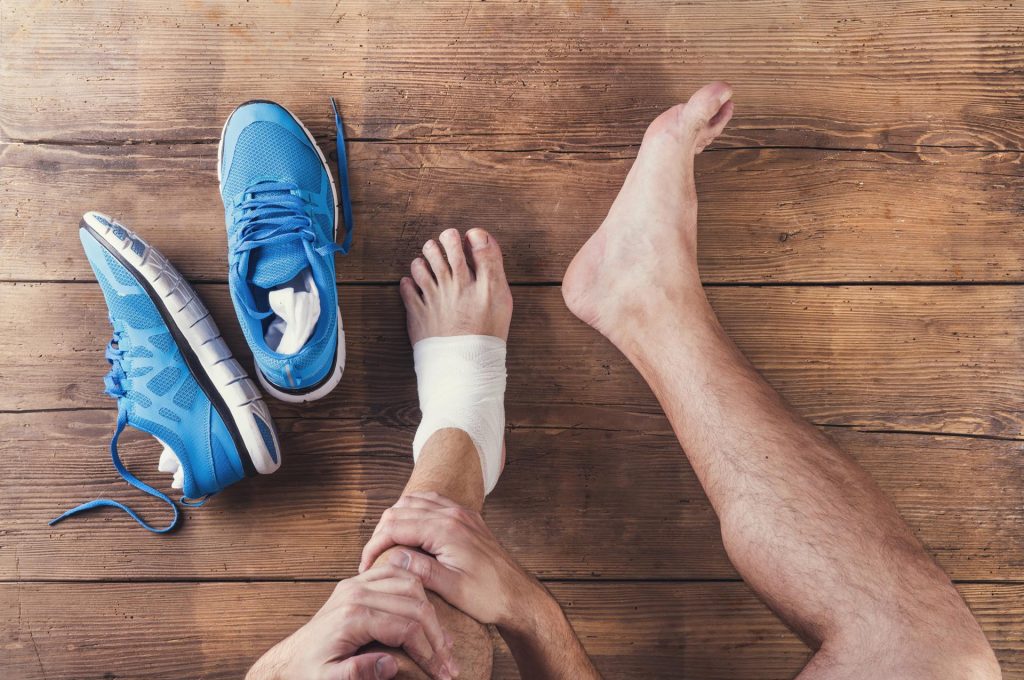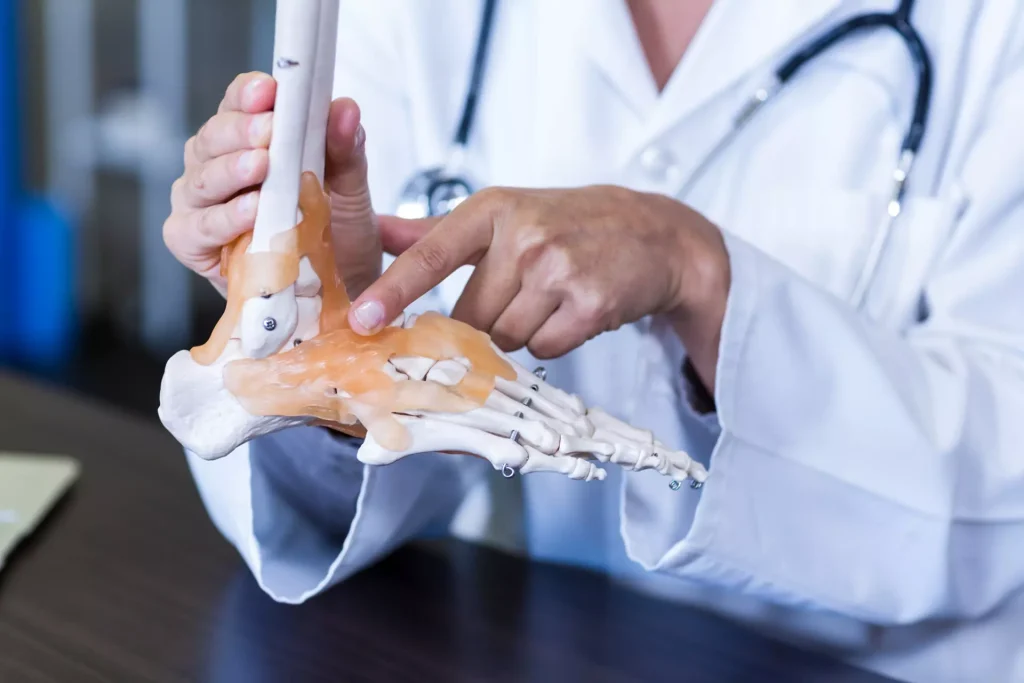
Luckily, we are highly skilled in treating a variety of conditions and issues. Whether you have slight discomfort or severe pain, we can provide you with care that allows you to live the lifestyle you want!
These are just some of the conditions, treatments, and services you will find at our podiatric office. Just ask us if you have any questions!

Haglund’s Deformity
What is Haglund’s deformity?
Haglund’s deformity is a common foot condition where a bony bump begins to form at the back of the heel bone where the Achilles tendon attaches to the heel.
The bony protrusion can cause severe pain while walking or wearing shoes as the bone rubs against the shoe.
This may cause the soft tissue at the heel to become irritated and may lead to another podiatry condition known as bursitis. Bursitis is a condition where the bursa, a fluid-filled sac between the Achilles tendon and bone, becomes inflamed and aggravated.
Causes This condition often occurs when there’s frequent pressure on the back of the heels. It can be caused by wearing shoes that are too tight or rigid in the heel. This includes skates, men’s dress shoes, women’s dress shoes, and steel-toed work boots. Heredity may also play a role in the development of Haglund’s deformity as inherited foot structures may increase your risk if you have a high arched foot, a tight Achilles tendon, or a tendency to walk on the outside of your heel. What are the symptoms of Haglund’s deformity? Haglund’s deformity can occur in one or both feet with symptoms ranging from mild to severe. These symptoms may include: Diagnosis Haglund’s deformity can be difficult to diagnose with symptoms alone because the symptoms can be similar to other associated foot issues such as Achilles tendonitis. After discussing the patient’s symptoms, our podiatrist will examine your foot and heel. Additional tests and screenings such as an X-Ray or MRI may help to evaluate the structure of the heel bone. Non-surgical treatments Non-surgical treatments for Haglund’s deformity are aimed at reducing inflammation or pain and removing pressure off the heel bone. Though these options may remove the symptoms of Haglund’s deformity, they do not shrink or remove the bony protrusion. These treatments may include: Surgery If conservative treatments do not provide adequate relief or if the condition is too severe, surgical intervention may be necessary. During this surgery, the doctor will remove the excess bone from the heel and smooth or file down the bone (if necessary) to remove pressure on the heel. Surgery can also repair a damaged tendon as a result of Haglund’s deformity. After surgery, it may take several months for you to completely heal and a cast or boot may be prescribed to protect your foot during recovery. A walking aid such as a walker or crutches may also be prescribed to you to help you move during recovery without placing pressure on the heel. Follow up appointments will be scheduled throughout your recovery to ensure that your heel is healing properly. Prevention You can lower your risk for developing Haglund’s deformity by wearing shoes that fit properly and using aids such as pads and orthotic supports to prevent friction, tension, and irritation. Remember to stretch before and after exercising, paying careful attention to the Achilles tendon to prevent tightening. If you are experiencing severe heel pain, please seek medical attention as this condition can worsen if left untreated. For more information on Haglund’s deformity or to schedule an appointment, please contact our office today.

Stress Fracture
Since nearly one-fourth of the bones in our body are in our feet, fractures of the foot are common and rarely debilitating. There are two types of fractures. A stress fracture typically occurs in the space between the toes and middle of the foot, usually as a result of a physical activity gone awry. These fractures are only on the surface of the bone. General bone fractures extend through the bone. These injuries are usually caused by trauma to the foot.
Depending on the fracture and placement, different treatments will be discussed. Foot fractures typically heal on their own, although more serious cases may require surgery.
It is important to seek medical attention as soon as possible if you suspect your foot is fractured so treatment can begin right away.
For more information on fractures or to request an appointment, don’t hesitate to contact us today at (859) 296-4272 - Lexington Office or (859) 236-5140 - Danville Office !
Request an Appointment
Tendonitis
Understanding Tendonitis
Tendonitis refers to inflammation of the tendons—the strong, flexible tissues that link muscles to bones. In the foot and ankle, this condition is a frequent source of pain and discomfort. It often stems from repetitive motion or overuse but can also result from poor stretching habits or improper technique during physical activity.
Common Symptoms of Tendonitis
Tendonitis may develop suddenly (acute) or progress gradually over time (chronic). Early signs usually include a persistent, dull ache. As the condition advances, the pain can become sharp or burning and may radiate through the foot or ankle. Other noticeable symptoms might include:
- Joint stiffness
- Swelling in the affected area
- Muscle weakness
- Tenderness to the touch
Types of Tendonitis in the Foot and Ankle
Several different tendons in the foot and ankle are prone to inflammation. The most frequently affected include:
- Achilles Tendonitis: This involves the Achilles tendon, which connects the calf muscles to the heel. Inflammation here can cause pain along the back of the lower leg and heel.
- Posterior Tibial Tendonitis: This affects the tendon running along the inside of the ankle. It plays a key role in supporting the foot’s arch and can become irritated or torn from overuse.
- Peroneal Tendonitis: These tendons are located along the outer ankle and help stabilize the foot. Repetitive stress can lead to inflammation in this area.
- Flexor Tendonitis: The flexor tendons, which assist in toe movement and arch support, may become inflamed, causing pain in the inner ankle or bottom of the foot.
Diagnosing and Managing Tendonitis
Prompt diagnosis and treatment are essential to prevent further tendon damage. A healthcare provider will typically assess your symptoms through a physical exam and review of your medical history. They may check for areas of tenderness, swelling, or signs of instability.
Treatment options are tailored to the severity of the condition. Mild cases can often be managed with conservative measures such as:
- Wearing supportive footwear
- Using orthotics or custom arch supports
- Temporary bracing or taping
If these approaches are not effective, further interventions such as anti-inflammatory medications or corticosteroid injections may be considered. In rare cases where symptoms persist, minimally invasive surgery might be recommended to repair or relieve the damaged tendon.

Fall Risk Assessment
Who Is at Risk of Falling?
While anyone can experience a fall, older adults—particularly those over the age of 65—are at a much higher risk. Falls are a leading cause of injury in this age group, and unfortunately, many of these incidents can result in serious complications. Recognizing your personal fall risk is the first step toward prevention.
Ask yourself the following:
- Have you taken a fall recently?
- Do you have arthritis in your feet or ankles?
- Do your legs feel weak or unstable when walking?
- Do you shuffle your feet, trip, or lose balance often?
- Do you need to hold onto furniture, walls, or handrails to steady yourself?
If you answered “yes” to any of these questions, it’s a good idea to speak with a podiatrist. They can evaluate your risk level and recommend a plan to improve your safety and mobility.
Fall risk assessments are tools healthcare providers use to evaluate how likely someone is to fall. These assessments help identify risk factors before an injury occurs. This is important because people who have already fallen once are more likely to fall again within the following year.
One common assessment is the Morse Fall Scale, which looks at several factors such as:
- Whether you’ve fallen before
- Any other medical conditions you may have
- Use of walking aids
- Your gait (how you walk)
- Mental alertness
Based on your answers, a score is calculated to estimate your level of risk:
- 0–24: Low risk
- 25–50: Moderate risk
- 51 and above: High risk
These assessments aren’t just for after a fall—they can be a proactive tool to stay safe, especially for older adults who may be hesitant to report minor slips or instability.
What Causes Falls?
Falls often result from a combination of internal (personal health) and external (environmental or behavioral) factors.
Internal causes may include:
- Weak muscles
- Poor balance or coordination
- Joint conditions like arthritis
- Posture instability
- Neurological conditions or mental health issues
- Bladder control problems
External factors might include:
- Inappropriate footwear
- Slippery or uneven surfaces
- Side effects of medication
- Lack of physical activity or poor fitness
- Incorrect use of canes, walkers, or other mobility aids
How a Podiatrist Can Help with Fall Prevention
Since many falls are linked to foot pain, instability, or alignment issues, podiatrists play a key role in prevention. They take a comprehensive approach that may include:
- A full fall risk evaluation
- Addressing foot and ankle pain or deformities
- Recommending supportive footwear or custom orthotics
- Prescribing ankle-foot orthoses (AFOs) if needed
- Guiding strength and balance exercises
- Educating patients on how to safely move and maintain stability
Ankle-foot orthoses, or AFOs, are specially designed braces that support the lower leg, ankle, and foot. These are customized for each patient and can significantly improve stability, especially in those with weakened muscles or joint issues.
